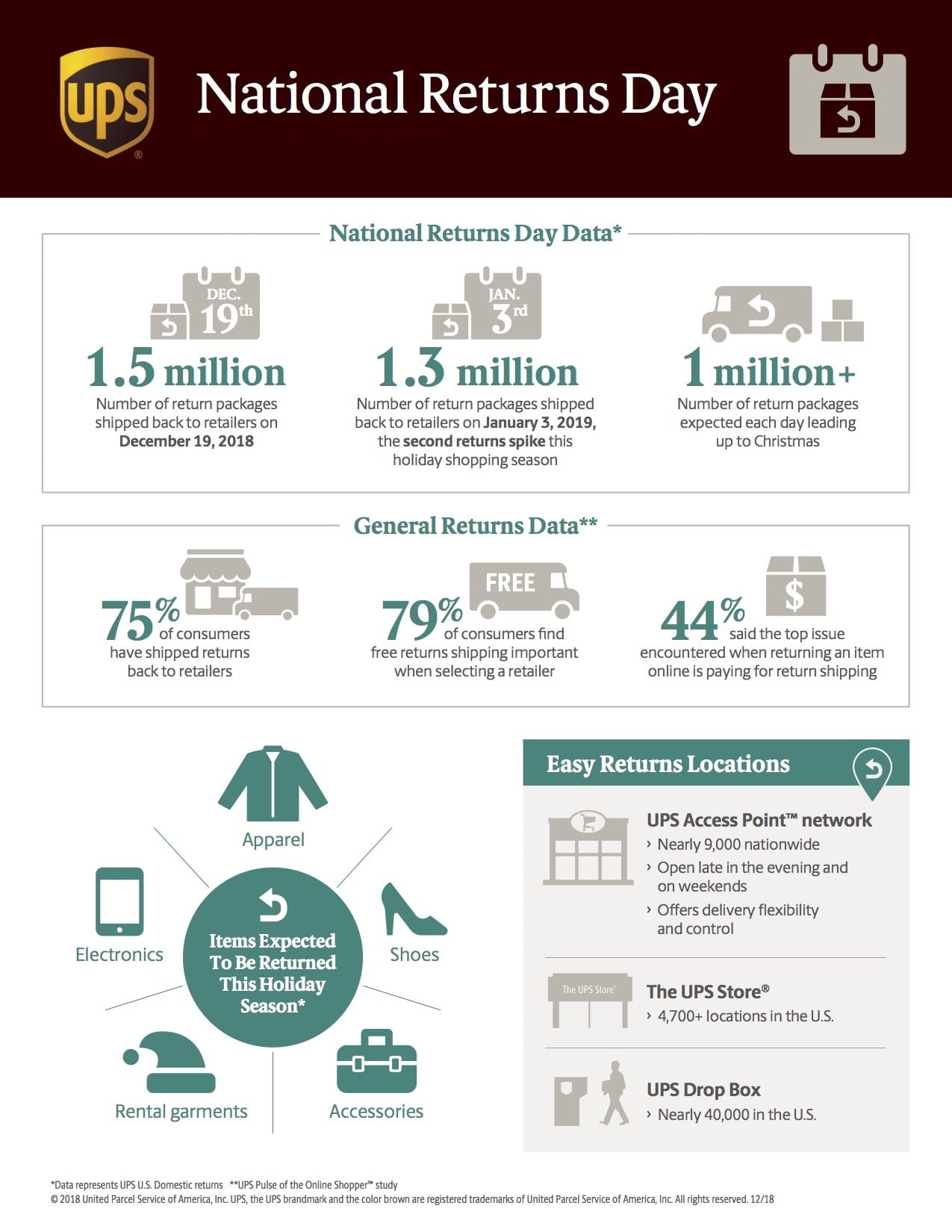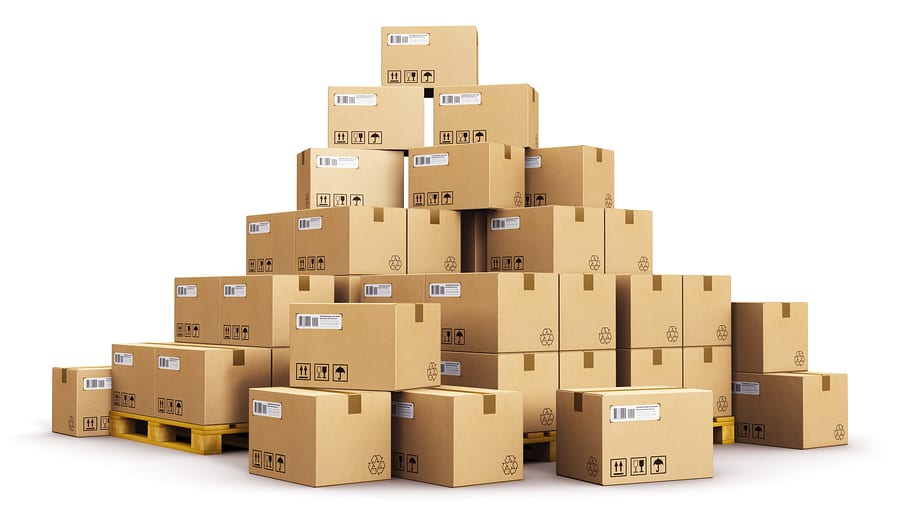Are you prepared for National Returns Day? It kicks off on January 2nd, 2020 and spans all the way to January 15th. According to the most recent ecommerce returns statistics, more than 44% of consumers returned an online purchase in 2019 alone. Following the holiday shopping rush comes the returns rush. Think tanks are estimating that more than 6 million packages will be returned during the first seven to ten days of January, with 1.5 million of them being returned on the 2nd. Make your store stand out by taking the hassles of out ecommerce returns with this step-by-step, illustrated guide.
Four Elements of a Great Return Policy
E-retailers have forever been focused on the “buying experience.” Striving to make this process as illustrated, efficient and smooth as possible. But commonly overlooked is the “after buying experience.” This after buying experience – which we delve into more detail in a related white paper about crafting your online retail returns policy – is just as important (if not more) than the actual buying experience.
Simply put: consumers know that it will be a simple and straightforward process for them to purchase goods from your online store. In just a few clicks, they can have their order placed. But what happens when they need to return an item?
There are four key elements that form the very foundation of your online retail returns policy, factors that play a strong role in conversion or a high bounce rate. These elements are highlighted in more detail in our related blog post “Convince and Convert with an Online Returns Policy Before It’s Too Late.”
The four basic, core tenants of any good online return policy include these following addendums:
- Communicate clearly to customers how your return policy works.
- Make the return policy convenient and simple so anyone can process a return quickly.
- Avoid charging any return shipping fees or restocking fees to encourage future sales.
- Be flexible with your return policy so that shoppers have a nice window of time to make returns.
But there are some additional things that you should consider when creating the ideal online product returns policy. We’ve honed the list down to the following practices and standards, none of which should be overlooked by any e-retailer that’s seeking to create a returns policy that actually helps them attract more sales, improve retention and boost customer loyalty.
1. Use Simple Language
If there is one thing that can be the saving grace with your online retail returns policy it’s the verbiage that’s being used. Cater to the average shopper and use simple, easy to understand language that is straightforward. This way, you don’t have to worry about a shopper mistakenly misconstruing your return policy for something other than what it really is.
2. Make it Easy to Find
Don’t count on shoppers navigating all the way to find the “returns policy” page. Rather, make the navigation to this page obvious. Online megastores like Zappos give a perfect example of how to make your returns policy banner plainly visible on the header of your site so that all new shoppers and returning visitors can easily see it.
3. Don’t Charge Fees
Studies have consistently uncovered two intrinsically linked elements of the online retail returns process. The first is that a majority of consumers do not want to pay any return shipping or restocking fees (no big shocker there). The second is that healthier long term sales, retention and loyalty have been documented, in a long list of related studies, with companies that offer these two cadres to customers. So follow suit, and better compete with online stores like Nordstrom’s, which makes returns cost-free, and you’ll be a step ahead with ecommerce returns best practices.
4. Make Returns Easy
Make sure your customers are aware of just what process is involved in them making a return to your online store. A great example of this can be found with ASOS. Customers are informed that returns are “fully tracked.” To place a return, they need to simply affix the prepaid return shipping label to their parcel and then drop it off at any USPS drop box or any post office. Be sure to educate customers on how simple your returns process is, too.
5. Offer Product Images & Videos
If a picture is worth one thousand words, then video is worth a million. Numerous studies have found that by adding video to your ecommerce store, you can secure more sales. This practice is now seen in place with e-retailers of all sizes, and it’s something that you should consider doing too. Also, videos of people using your products, or wearing them, can help reduce the rate of returns because shoppers can get a better idea of whether or not said product is a fit for them.
6. Offer Product Reviews
Big e-tail names like Amazon have forever relied upon the customer feedback and reviews section to supercharge sales. Reviews are relied upon by many shoppers when trying to make a buying decision. They also help prevent unnecessary returns, too, because shoppers can find out what other people liked or disliked about said product before they make a buying decision.
7. Integrate Sizing Apps
A number of software companies now offer enterprise-grade fitting tools and sizing apps that are designed to help reduce the rate of apparel returns online. At the forefront is a company called VirtuSize, which is the leading online fitting solution. This sizing app can be integrated into almost any online apparel store to help customers find the right size the first time, and to exponentially decrease the rate of clothing returns online.
8. Consider Free Trials
Thinking outside of the box a bit can also help you decrease the rate of online product returns. A great example of this can be found with free trials on commonly returned items like apparel. Retailers like Gwynnie Bee offer a 30-day free trial to all shoppers. They can try the clothing before the buy, and they can return what they don’t want at no charge.
9. Returns Are Part of Ecommerce
According to the hard data, about one-third of all products that are purchased online are ultimately returned by consumers. What needs to be offered to customers prior to them making the purchase is assurance that returns won’t be an issue. Companies like Obey Clothing streamline the online retail returns process and enhance consumer confidence. Returns can be processed instantly online by merely filling out a simple form and generating a prepaid return shipping label.
10. Keep Your Customers Updated
Once customers have processed a return, make sure that you keep them informed. Send them a return processing email that includes the details of their return. Retailers like Next Directory offer a simple update or email can improve customer retention and needs to only provide simple data regarding the customer’s processed return.
11. Good Returns Management
Returns management is an imperative aspect of running your ecommerce store. Without the right standards and practices in place, you could be alienating customers and dissuading them from making a purchase. What’s more, you could be hindering future purchases as well as deterring prospective customers who visit your site from completing a sale.
Wondering how an effective online product returns policy can actually improve your profit margins and attract more sales? Make sure you read our related white paper about online retail returns; it references authority sources from related studies that demonstrate that an efficient returns policy can actually increase revenues by as much as 25% in just six months.
12. Become a Master of Returns
Getting your returns policy in order will require some effort on your part. But if you take the time to learn the ins and outs, and to truly master the process, it will benefit your bottom line in the long term. We’ve got you covered here, too. Learn everything there is to possibly know about this process in our Ultimate Guide to Ecommerce Returns. Find out why easy returns result in more long term profits, and how you can make the returns process a breeze for your customers so keep coming back to your store in the future.











